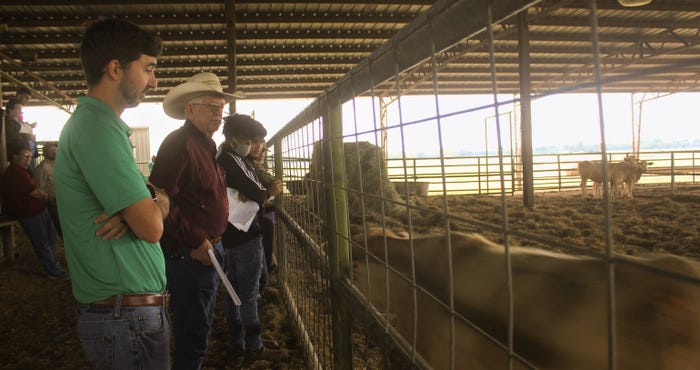
Visitors to the LSU AgCenter Beef and Forage Field Day observe as cattle are pen scored for temperament. Running along fences is a sign of “moderately aggressive” temperament. Ginger Rowsey
The Northeast Louisiana Beef and Forage Field Day was held September 16 at the Goldmine Plantation in Mangham, La. Field Day visitors heard from LSU AgCenter livestock specialists and a local veterinarian on best practices for cattle operations as we move into fall and winter. Here are three key takeaways from the event.
1. Get the vaccine
No, there was no mention of COVID vaccines, but rather best vaccination protocols for cow-calf herds. Dr. Bat Brantley, of Union Veterinary Clinic in Farmerville, La., said an experimental vaccine developed by Gene Luther with the LSU AgCenter was the best prevention for anaplasmosis, a costly and often fatal disease that occurs regularly in Louisiana cattle herds. Breeding age cows and bulls are most susceptible, and signs of the disease can be sudden and acute.
“In every case of anaplasmosis I saw last year, death was the first sign owners saw,” Brantley said.
“There are treatments available for anaplasmosis,” Brantley continued, “but by the time cattle are recognized as having clinical signs, they may be so sick that treatment is too late to be effective.”
Treatments include an oxytetracycline antibiotic as well as a chlortetracycline that can be supplied in feed and mineral supplements. However, a Veterinary Feed Directive (VFD) is required for oral use and Brantley cautions that not all cows will consume enough for prevention. Plus, producers must have a confirmed case of anaplasmosis to get a VFD, and in Brantley’s experience a confirmed case most likely means a dead cow.
“The best prevention is vaccination,” Brantley said. “It is expensive up front ($7.50/dose + booster and must be administered by a veterinarian) but it’s probably cheaper than feeding chlortetracycline for six months, and it is more effective.”
2. Wild cows cost you money
Unless you’re trying to win prize money at the rodeo, most cattlemen probably prefer cows with a good temperament. Jason Holmes, regional livestock specialist with LSU AgCenter says calm cattle are not just making your operation safer, they are making it more profitable.
“Excitable animals have an elevated concentration of stress hormones throughout their lifetime which negatively impacts growth performance, carcass traits like marbling, response to vaccination and immune challenges,” Holmes said. “In a feedlot, these excitable cattle tend to have lower average daily gains, lower carcass weights and increased treatment costs, which results in lower net profits.”
With fuel and fertilizer prices continuing to rise, Holmes said cattle producers are looking at tight margins. LSU AgCenter research shows docile cattle can save producers as much as $7 to $9 per head compared to aggressive cattle when you account for losses in weight gain, and increased costs and added time spent for treatment.
“In a good year, that may not be as important,” Holmes said, “but in a year like this one, $7 to $9 can make a difference.”
Holmes recommended using the Beef Improvement Federation Pen Score and Chute Score Guidelines for identifying temperamental cattle.
“Temperament is a moderately heritable trait, so elimination of the most temperamental cattle from a breeding herd will improve the herd’s overall performance,” Holmes said.
3. When it comes to fertility, put your cows to work
With fertilizer prices through the roof, many cattlemen in attendance were looking for ways to save on fertility this year without causing long-term issues.
“The best thing I can tell you is capture nutrients that cows will apply for you,” said Wink Alison, associate professor with LSU AgCenter.
While cattle consume a lot of nutrients in the forage, only a small percentage of those nutrients are retained in their bodies. According to Alison, cows excrete 80 – 90% of the nutrients they take in. The better job a rancher can do managing the natural nutrient cycle, the less money will be required for pasture fertilization.
“You have to manage where animals are putting nitrogen,” said Alison. “If you have continuously stocked pastures, I’ve observed that most nutrients will end up in the shaded areas and the nutrient cycling is not impacting the majority of the field.”
Changes in grazing management can make big changes in the effectiveness of the N-cycle. Short grazing periods that leave taller residuals after grazing are more effective than grazing shorter through a longer period. More green residue will also keep soils cooler, which will reduce losses of nitrogen through the atmosphere as ammonia gas.
About the Author(s)
You May Also Like






